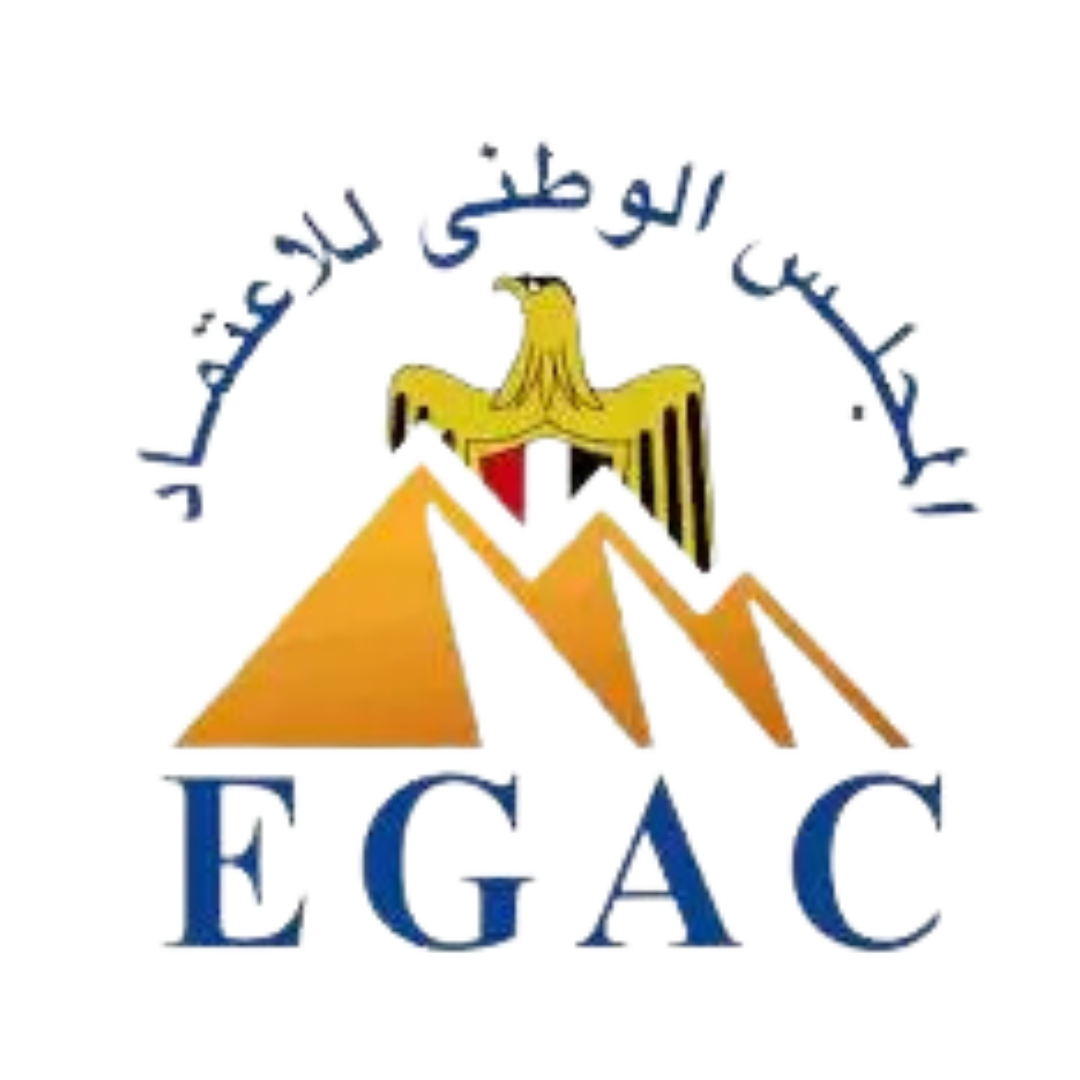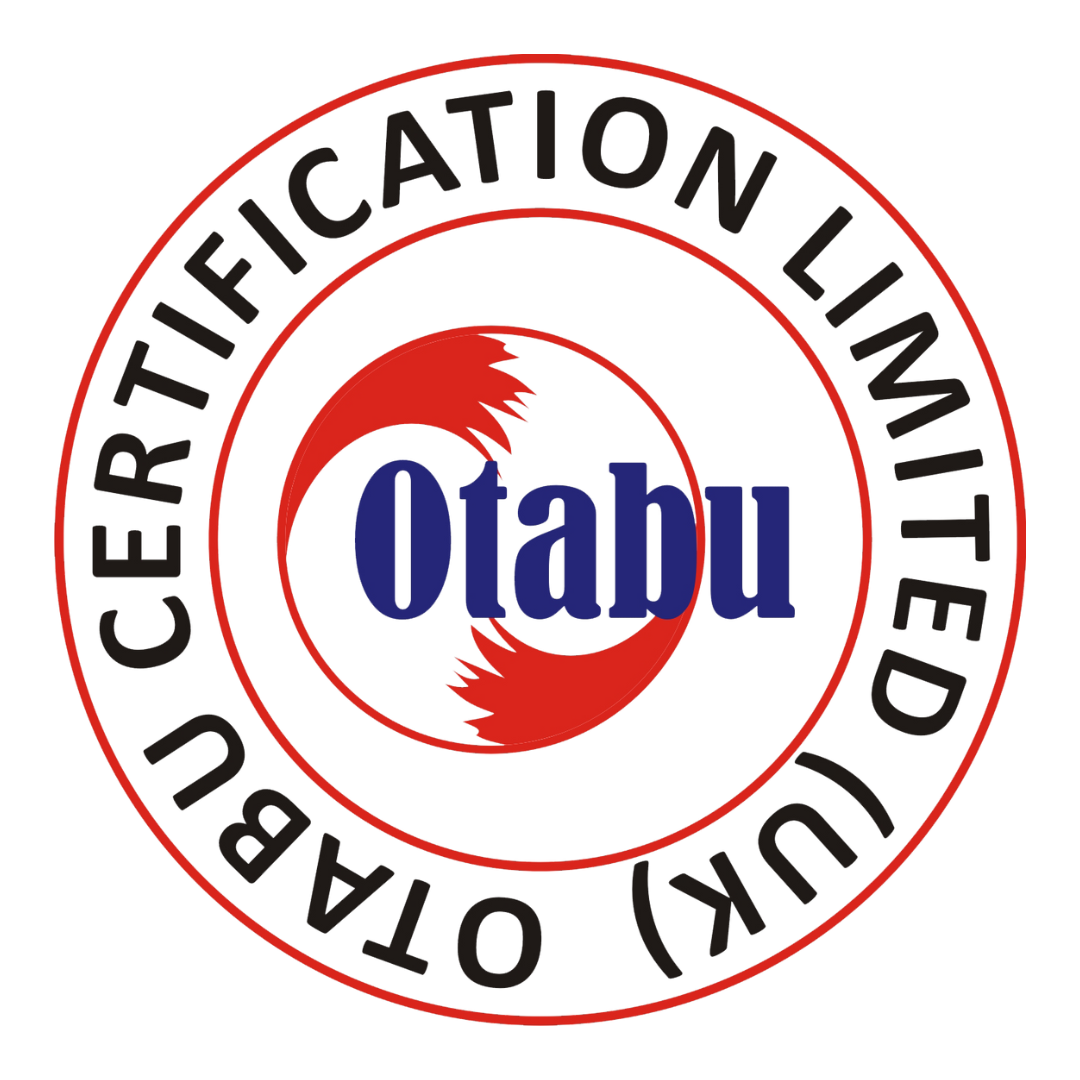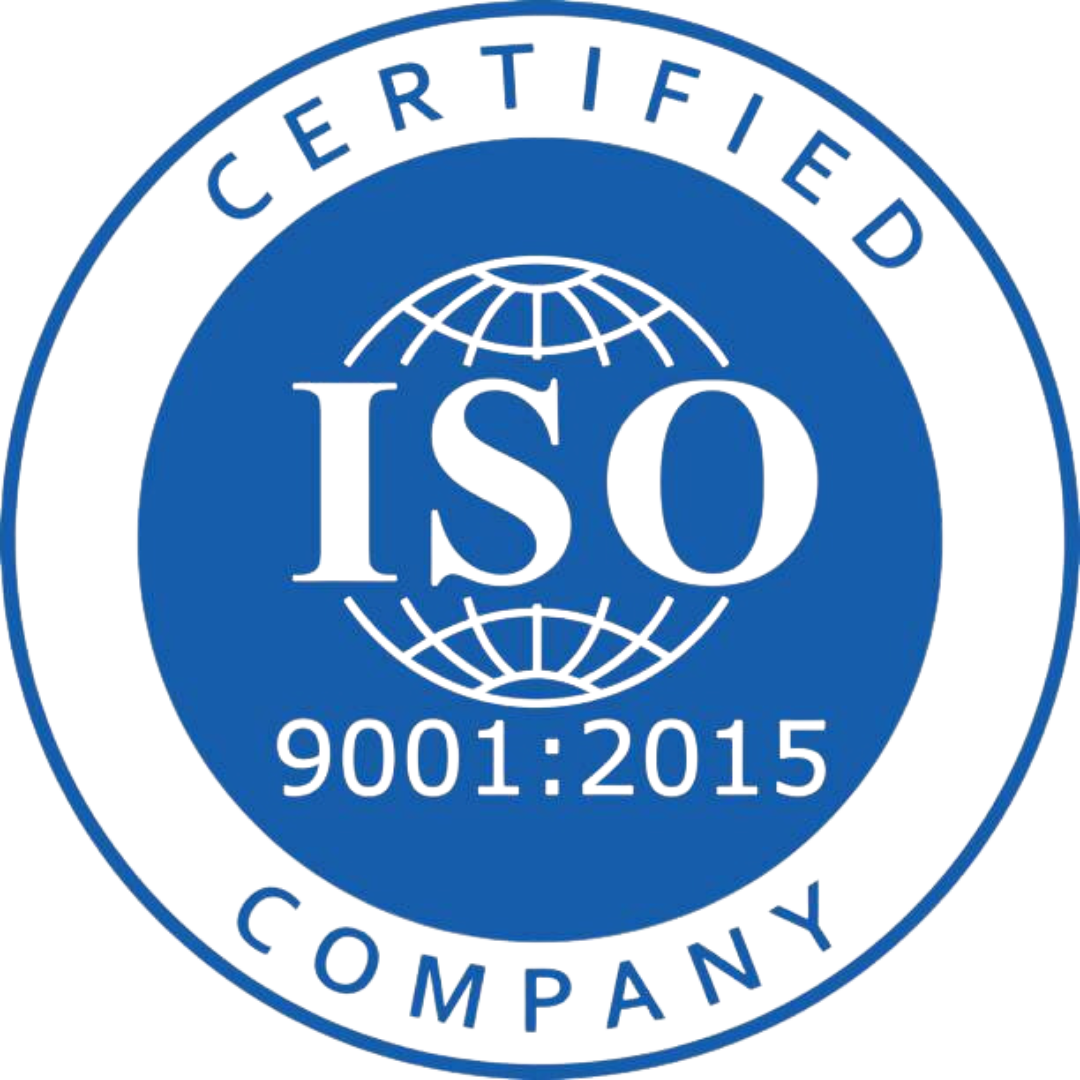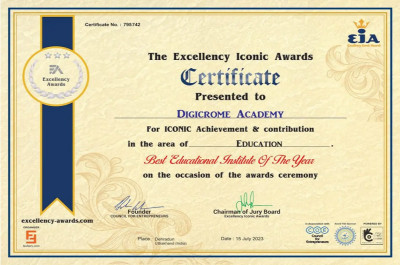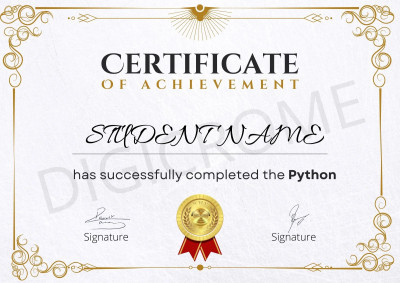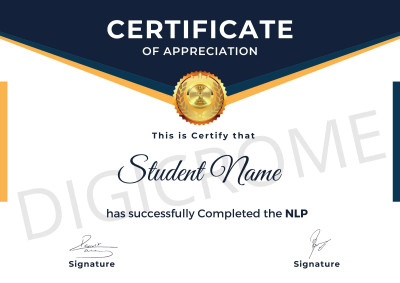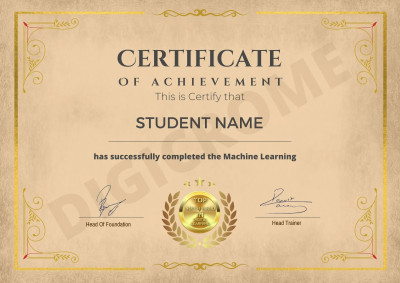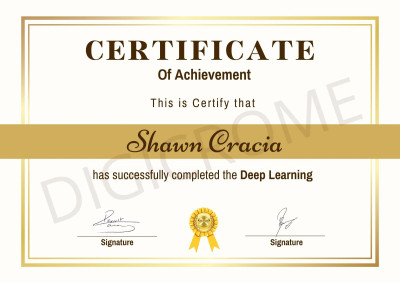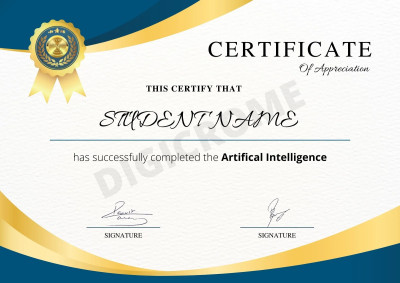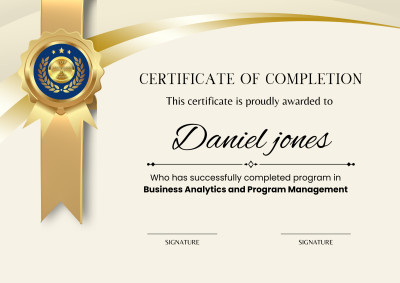Program Overview
Unlock the door to a rewarding career as a Full Stack Developer with Digicrome's comprehensive Full Stack Development Professional Certification Program. This program equips aspiring individuals with the essential skills and knowledge required to excel in the dynamic field of Full Stack Development. Whether you're a seasoned professional or a fresh graduate, this course is designed to propel your career to new heights in the world of technology.
Why Choose Digicrome?
At Digicrome, we believe in providing top-notch education and training crafted by experienced Full Stack Professionals. Our curriculum covers all aspects of Full Stack Development, ensuring that participants gain expertise in designing and developing web applications using the latest technologies. With demo sessions offered before training, candidates can experience the quality of our courses before committing.
Objectives of Full Stack Development Professional Certification Training:
The main objectives of this certification program include:
- Mastering the design and development of web pages and applications using Front-End Technologies such as HTML5, CSS3, JavaScript, jQuery, Bootstrap, Angular, or React JS.
- Gaining proficiency in Back-End Languages such as NODE JS, JAVA, PYTHON, or PHP.
- Understanding and utilizing development frameworks like Hibernate, Java Spring, etc.
- Working with databases including Oracle, MongoDB, MySQL, and SQL Server for data storage purposes.
Prerequisites:
To enrol in the Full Stack Development Professional Certification Training, candidates should have:
- Basic knowledge of programming languages such as Java, PHP, Python, .Net, or Ruby.
- Good communication skills.
- Familiarity with database tools like MySQL, MongoDB, or Oracle.
Who Should Take This Training?
This course is suitable for:
- Programmers
- Aspiring individuals and professionals
- Fresh college graduates
- Professionals with experience in database management
Benefits of Full Stack Development Professional Certification:
- Full Stack Developers are in high demand, with recruiters actively seeking certified professionals.
- Endless opportunities and career growth potential await those skilled in Full Stack Development.
- Higher paybacks make this course a lucrative choice for professionals seeking a rewarding career.
- The field of Full Stack Development offers stability and growth, making it an ideal time to get certified and expand your skill set.
Course Highlights:
- 120 hours of comprehensive training covering all aspects of Full Stack Development.
- In-house study materials are provided along with published materials to aid the learning process.
- Interactive sessions and group activities ensure active participation and engagement.
- Practical project work assignments allow individuals to apply learned concepts in real-world scenarios.
Conclusion:
Don't miss the opportunity to embark on a fulfilling career journey in Full Stack Development with Digicrome's Full Stack Development Professional Certification Program. Enrol now to unlock endless possibilities and propel your career to new heights in the ever-evolving world of technology.
Full Stack Development Professional
- ₹70000.00
Features
- Job Assistance
- Industry Based Trainers
- Multiple Simulation Exams
- Course Completion Certificate
Key Highlights
 Job Assistance
Job Assistance Industry Based Trainers
Industry Based Trainers Multiple Simulation Exams
Multiple Simulation Exams
 Course Completion Certificate
Course Completion Certificate
 Expert Experienced Trainers
Expert Experienced Trainers
 1:1 Doubt Session
1:1 Doubt Session
 Learning Management System
Learning Management System
 24*7 Career Support
24*7 Career Support
Program Objective
- Introduction HTML
- HTML Basics
- HTML Elements
- HTML5 Semantic
- HTML Attributes
- HTML Headings
- HTML Paragraph
- HTML Styles
- HTML Formatting
- HTML Quotations
- HTML Computer Code
- HTML Comments & Colors
- HTML CSS, Links and Images
- HTML Lists
- HTML Blocks
- HTML Classes
- HTML Layout
- HTML Responsive
- HTML iframes
- HTML JavaScript
- HTML Head
- HTML Entities and URI
- HTML Symbols and XHTML
- HTML Charset and Forms
- Quiz
- Assignment
- Introduction CSS3
- CSS3 Syntax
- CSS3 How To
- CSS3 Colours
- CSS3 Backgrounds
- CSS3 Boarders
- CSS Padding
- CSS Height/Width
- CSS3 Gradients
- CSS3 Shadows
- CSS3 Text
- CSS3 Fonts
- CSS3 2D Transforms
- CSS3 3D Transforms
- CSS Links
- CSS Lists
- CSS Tables
- CSS Box Model
- CSS Outline
- CSS Display
- CSS Max-width
- CSS Position
- CSS Float
- CSS Inline-block
- CSS Align
- CSS Combinators
- CSS Pseudo-class
- CSS Pseudo-element
- CSS Navigation Bar
- CSS Dropdowns
- CSS Tooltips
- CSS3 Images
- CSS Attr Selectors
- CSS Forms
- CSS Counters
- CSS3 Animations
- CSS3 Buttons
- CSS3 Pagination
- CSS3 Multiple Columns
- CSS3 User Interface
- CSS3 Box Sizing
- CSS3 Filters
- CSS3 Media Queries
- CSS3 Responsive
- Quiz
- Assignment
- Introduction to JavaScript
- Java Script Language Basics
- JavaScript Objects
- JavaScript Scope
- JavaScript Events
- JavaScript Strings
- JavaScript Numbers
- JavaScript Math
- JavaScript Arrays
- JavaScript Boolean
- JavaScript Comparisons
- JavaScript Conditions
- JavaScript Switch
- JavaScript Loops
- JavaScript Type Conversion
- JavaScript RegExp
- JavaScript Errors
- JavaScript Debugging
- JavaScript Hoisting
- JavaScript Strict Mode
- JavaScript Functions
- JavaScript Objects
- JavaScript Forms
- JavaScript HTML DOM
- JavaScript BOM
- Quiz
- Assignment
- Introduction to jQuery
- jQuery Syntax
- jQuery Selectors
- jQuery Events
- jQuery Effects
- jQuery HTML
- jQuery Traversing
- jQuery AJAX &Misc
- Quiz
- Assignment
- Introduction to Bootstrap
- Bootstrap Basics
- Bootstrap Grids
- Bootstrap Themes
- Bootstrap CSS
- Bootstrap JS
- Quiz
- Assignment
- Introduction to ES 6
- Let and Constant
- Arrow Function
- Template Literals
- Class and Inheritance
- Rest parameter and Spread Operator
- Map ,Filter and Reduce function
- Modules
- Destructuring
- For in and For of loop
- Introduction to Typescript
- Environmental Setup
- Types
- Object Oriented Features
- Interfaces
- Modules
INTRODUCTION TO ANGULAR
- What is Angular
- What is SPA
- Comparison between different versions
- Advantages and Disadvantages
- Key features
ENVIRONMENTAL SETUP
- Node /NPM
- Angular CLI
- Setup Project
- Directory Structure
- Code Editors
- How Angular Application Boot
MODULES
- What is Module
- Decorator
- NgModule
- Core Module
- Bootstrapping
- Shared Modules
COMPONENTS
- Introduction to Components
- Component Architecture Patterns
- Metadata
- State and Behaviors
TEMPLATES
- Template Expression or Interpolation
- Data Binding (Event ,Property , Two Way) *ngIf , *ngFor , *ngSwicth
- Built-in Structural and Attributes Directive
PIPES
- Built-in Pipes
- Custom Pipes
Routing
- Routes , RouterModule , routerLink
- Child Routing
- Params
- Guards
CUSTOM DIRECTIVES
- Structured Directives
- Attribute Directives
VALIDATIONS
- Template Driven
- Reactive Form
- Custom Validators
ASYNCHRONOUS OPERATIONS
- Observable vs Promise
- Network Call
- HTTP Request | Response
SERVICES
- Introduction to Services
- Building a Service
- Dependency Injections
- Injectors and Providers
LIFECYCLE HOOKS
- Component LifeCycle
- All LifeCycle Hooks
LOCAL DATA STORAGE
- Local Storage
- Session Storage
- Cookies
COMMUNICATION BETWEEN COMPONENTS
- @Input()
- @Output() with EventEmitter
- @Viewchid()
- Shared Service
- Subject
SERVER-SIDE RENDERING
- Introduction to Server-Side Rendering
- Angular Universal
Angular Testing
- Introduction to Testing
- Unit Testing with Karma and Jasmine
LAZY LOADING
Redux, RxJs and Ngrx Store
UI COMPONENTS
- Angular Material
- PrimeNG
Third Party Modules
- Social Login
- Pagination
- Search
- Filter
- JWT Token
- File Upload
- Many More
Project
- Build a Product List Web App in Angular
Implement CRUD functionality in Angular and build an Angular app with the following features: Product form, product list, view, delete, and update products from the list.
INTRODUCTION TO REACT JS
- What is React JS?
- What is SPA?
- DOM vs Virtual DOM
- Advantages and Disadvantages
- Key Features
ENVIRONMENTAL SETUP
- Node | NPM
- Installation of CLI
- Setup Project
- Directory Structure
- Code Editors
- How React JS Application Boot
BASIC FEATURES OF REACT JS
- React Concepts
- JSX and TSX
- Render Elements
- Function and Class Components
- Props and State
- Handling Events
- Dynamic Data Rendering
- Property Binding
KEY FEATURES OF REACT JS
- Conditional Rendering
- List and Keys
- Forms Handling
- Forms Validations
COMPONENT LIFECYCLE HOOK
- Understanding component lifecycle
- All Lifecycle Hooks
EVENT HANDLING REACT
- Understanding React Event System
- Passing arguments to event Handlers
NETWORK CALL
- Fetch
- Axios
CUSTOM SERVICES
- Introduction to Services
- Building a Service
LOCAL DATA STORAGE
- Local Storage
- Session Storage
- Cookies
ROUTING WITH REACT ROUTER
- Setting up React Router
- Configuring route with Route Component
- Making routes dynamic with Route Params
- Working with nested routes
- Link and NavLink
- Redirect Routes
UI COMPONENTS
- Angular Material
- PrimeNG
INTRODUCTION TO REDUX
ADVANCE REDUX
- Why Redux
- Install and setup
- Store ,Reducer , actions
- Dispatcher
- High order Components
- mapStateToProps and mapDispatchToProps usage
- Async Actions
- Middleware
- Redux Thunk and Redux Saga
React Hooks
- Why we need Hooks.
- Different types of Hooks
- Using state and effect Hooks
- useReducer ,useRef etc.
- Custom Hooks
- Rules of Hooks
Third Party Modules
- Social Login
- Pagination
- Search
- Filter
- JWT Token
- File Upload
- Many More
Rest Js Testing
- Jest with Enzyme
Project
- Build a Product List Web App in React Js
Implement CRUD functionality in React Js and build an React Js app with the following features: Product form, product list, view, delete, and update products from the list.
Introduction:
Introduction to Node.js
- What is node.js
- A word on event loop
- Event driven architecture
- Blocking vs non-blocking code
- Node Process Model
- Setup node.js
- Node REPL
- Debugging node.js app
Modules in JS
- Understanding exports and require
- Creating modules
- Importing modules
- Quick tour on NPM
- Installing 3rd party modules
Events & streams
- Significance of Events
- Event Emitter class
- Emitting and listening to events
- Types of streams
- Working with streams
- Composing streams using pipe
Working with Process and File System
- Process object
- Handling exceptions at process level
- Listening to process events
- Working with file system using fs module
- Creating, Copying, Deleting files
- Creating, Copying, Deleting directories
- Watching for file changes
HTTP
- Building a Web Server
- HTTP Request Methods, Headers
- Response Codes and Headers
Realtime programming with Socket.io
Express Js:
Express js Introduction & Setup
- Installing express
- First App with express - Demo
- Little about routes
- Little about Express middleware
- Serving static files with express
- Express application generator
Routing
- Route Methods
- Route Paths
- Parameterized Routes
- Route Handlers
- Express Router
Middleware
- Types of middleware
- Application
- Router
- Error
- Built-in
- Third-party
- Error middleware
- Body parser, cors , cookie parser, session management
Template Engines
- What are template engines
- EJS
- Jade
- Handlebars
Expressjs security
- Authentication
- JWT
- Securing routes
Debugging in Express
Mongo Db:
Introduction to MongoDB
- Installing MongoDB
- The current SQL/NoSQL landscape
- Document-oriented vs. other types of storage
- Mongo's featureset
- Common use-cases
- MongoDB databases
- MongoDB Collections
- MongoDB Documents
CRUD Operations in Mongodb
- Creating documents
- insert()
- update()
- save()
- Querying documents
- find()
- Working with equality
- Query operators
- Building complex queries
- Updating documents
- Deleting documents
- Limit
- Order By
Introduction to Mongoose
- Word on ORM/ODM
- Installing mongoose
- Connecting to MongoDB from mongoose
Core concepts of Mongoose
- Understanding mongoose schemas and datatypes
- Working with Models
- Using modifiers in schema
- Using virtual fields
- Optimizing query performance by enabling indexes
Project:
Develop a complete Ecommerce Web Application
- Admin Panel (React or Angular)
- Front End (React or Angular)
- Backend (Node Js , Express Js ,Mongodb)
Key Features
- Authentication and Authorization
- Social Login Integration
- Password Encryption
- JWT Token
CI/CD Cloud :
Introduction:
PHP is the most popular server side scripting language used to develop dynamic web applications. It is an Open Source. In PHP there are many frameworks which follow MVC Design Pattern like Larvel , Code Igniter , Zend etc and CMS also like Word press , Drupal , Magneto etc.]
PHP language building blocks
- Installation of PHP
- PHP delimiters
- Variable initialization with PHP
- PHP Data types
- PHP Constants
- PHP Operators
Conditional Statements
- If else
- If else if else
- Nested If
- Switch Case
- Jump Statements ( Break , Continue , Exit )
Looping (Iteration)
- For loop
- While loop
- Do While Loop
- Nested Loop
INTRODUCING ARRAY
- Index based arrays
- Associative Array
- ulti-Dimensional Array
MANIPULATION USER INPUT
- Presenting the user with input
- Retrieving form data with $_POST,$_GET and $_ REQUEST
- Preserving Data in Form inputs
FUNCTION
- Introducing Functions
- Deï¬ne functions
- Using parameters
- Returning values
- Call By Value & Call By reference
- Reusing Codes
- Array , String , Math , Date functions
- Super Global Array Variables
- Deleting Cookies
- Implementing Query String
INTRODUCING WITH THE FILE SYSTEM (FILE & HANDLING)
- Saving data for later using ï¬le system.
- Opening aï¬le
- Creating and Writing to a ï¬le
- Creating and Writing to a ï¬le
- Using other useful ï¬le functions
- Create a directory
- Remove a directory
- File Uploading & Downloading
- File uploading Concepts
- Multiple File Upload
STATE MANAGEMENT
- Session, Cookie , Query String , Hidden Field
- What is Session ?
- Starting a Session
- Registering Session variables Using Session Variables
- Destroying the variablesandSession
- What is a Cookie?
- Setting Cookies with PHP Using Cookies with Sessions
- Deleting Cookies
- Implementing Query String
MYSQL DATABASE
- Relational Database Concept and technology
- Web Database Design
- Web Database Architecture
- Creating a MySQL Database
- Creating Database
- Tables Column
- Data Types
- Implementing Insert/Delete/Update and select
- Query Aggregate
- Functions
- Having and Group By Clause Joining Table
- Implementing Primary key, Unique Key, Composite key, foreign key, default constraint etc.
- Joining Table
- Dropping Tables and Databases
- Introduction to Phpmyadmin
DATABASE CONNECTION
- My SQL Connectivity
- Procedural Connectivity
- Object Oriented Connectivity
- PDO Connectivity
JQUERY WITH AJAX
- jQuery introduction
- jQuery Selectors , events , DOM , animations
- jQuery accordions, carousel, tab
- Ajax Implementation
- CRUD Operation with AJAX
OBJECT ORIENTED PHP
- Object oriented concepts
- Classes, objects and operations
- Class attributes
- Access Modiï¬er Constructor & Destructor
- Inheritance Static method Type
- Hinting Object
- Cloning Abstract class
- Final keyword Inheritance
ADVANCE PHP TECHNIQUES
- Implementing Captcha , PDF Generation
- Excel or CSV Generation Email with PHP
- Implementing Pagination
- SQL Injection
- Web Services with JSON
- Payment Gateway
- Integration Error tracking and debugging
- Exception Handling
DEVELOPING A DYNAMIC WEB APPLICATION
CODEIGNITER (Frameworks )
Introduction
- Inroduction Of Controller
- CI_ Controller , Request Parameters, Actions Controller
- Methods & Attributes
- Creating
- Core Controller Class
VIEWS
- Creating Views
- Layouts (Use Image, CSS, Bootstrap, JS)
- Calling in controller
- Helpers (FormHelper , HTML Helpers) in Views
MODELS
- Creating Model
- How to Load in contorller
- Calling in Controller
- Apply The Business logic
- Creating Core Model Class
HELPERS
- Introduction
- How to load Helper
- Apply To Controller and Views
- Creating Own Helper
- How to override other Helper
LIBRARIES
- Introduction
- How to load Library
- How to override other Libraries
DATABASE
- Introduction
- How to Conï¬gure
- Active Records and Query Builder
- CRUDS operation (Create Insert Update Delete and Search)
- Form Validation , Session , Pagination , Uploading
DEVELOP A WEB APPLICATION IN CI
LARAVEL
- Introduction of Laravel
- MVC Laravel routing
- Installing Composer and Command line tool
- Blade essentials
- Resource
- Laravel Route groups and ï¬lters
- Working with Database
- Eloquent CRUD
- Laravel Query Builder
- Eloquent relations
- Laravel Migrations
- Laravel Database
- Seeding Forms and Validation
- Setting up laravel form
- Validation a form
- CreatingAdmin Pos
- Creating a Frontend
- Setting up the Blog
- Securing the admin panel
- Handling routing
- Establishing an HTML View
- Creating Tables with Schema Builder
- EnablingVersionControlwith Migrations
- Querying with eloquent
- ORM Displaying
- Laravel Code
- Working with Blade
- Templating Deï¬ning
- Conditions Integrating form elements
- Setting up Authentication
- Creating a registeration form
- Securing Content
- Authenticating users in Laravel Application
- Restful API’s Creation
- Lumen : Micro-framework (API’s and Micro Services)
DEVELOP A WEB APPLICATION LARAVEL
Program1:Python
- Hello World
- Variables
- Basic Arithmetic & logical operators (int, float)
- Data Types - numbers, boolean & strings
- Concate, Subset, Position, length etc.
- If-else, loops
- Logic Flowcharts (Intuitive understanding of code flow)
- Pseudo Code
- Basic Programming syntax
- List, Tuples, Sets & Dictionaries
- Default functions
- Default methods
- Intro to Conditional statements (if-else, elseif), Nested Conditional in Python
- Intro to Basic For, While Loops, Break in Python
- List Comprehension
- Use cases vs Loops
- Write Programs including both loops and If-else
- Practice list comprehensions
- Exploring commonly used built in functions (min, max, sort etc.)
- Programming user defined functions
- Working with functions with and without arguments
- Functions with return items
- Understanding lambda functions
- Overview of map, reduce and filter functions
- OOPS Concept- Detailed Introduction
- Inheritance-Multi level Inheritance, Single level Inheritance
- Encapsulation
- Polymorphism
- File Operations
- Exception Handling
- GUI Programming
Program2: Django framework
INTRODUCTION TO DJANGO
- What is Django
- HTTP request andresponse
- Django Model View Template architecture
- Django installation
- Virtual environment setup
- Starting your First Django Project
DJANGO APP ARCHITECTURE
- Django project environment
- Understanding settings.py
- Start a new Django app
- Django app components
- Adding the app to your project
- Creating Django Skeleton App
DJANGO MODELS
- Understanding the Database tier of web-application
- Defining DjangoModels
- Understanding ModelFields & Options
- Importance of str() method
- Creating a DjangoModel
- Django make migrations and migrate
- Django model relationships
- Changing the Database Engine
DJANGO ADMIN
- Enabling the Admin Interface
- Creating Admin SuperUser
- Creating other Users and Groups
- Add, Change, View, Delete permissions
- Register Model with Admin
- Model Admin and Admin Options
DJANGO URLS
- Django project urls.py
- Django app urls.py
- Django url patterns and path
- Django Template View
- Django URL patterns
DJANGO VIEWS SimpleGenericViews
- Using Django HttpResponse object
- Understanding render() object
- Using redirect()
- Other Generic Views
- Class based views
DJANGO ORM & QUERY SETS
- Understanding Django ORM
- Django Queryset API
- Methods that return new QuerySets all(),filter(), order_by(),distinct(),values(),values_list()
- Methods that do not return new QuerySets get(),count(),create(),update(),delete()
- Two or more QuerySets union(), intersection(), difference(), AND(&), OR(|), Qobjects
- Field lookups exact, iexact, contains, in, gt, gte, lt, lte, startswith, endswith, range
DJANGO FORMS
- Understanding Django Forms
- Model Form Class
- Form validation
- HTML forms
- Select field and dependent dropdown fields in Django forms
- File field & Image fields informs
- Date, Time and Duration Field in Django forms
DJANGO USERS & AUTH
- Django Users and Groups
- Django Authorizations:add, change, view, delete
- Django Authentication, login and logout
- Create a Django User Registration app
DJANGO TEMPLATES & STATIC FILES
- Understanding Django App Presentation Layers
- Creates templates and static directories Template tags and filters
- Template inheritance
- Static files reference:images, css and javascript
DJANGO TESTS & EXCEPTIONS
- Using Python’s UnitTest library
- Writing Django Tests
- Debugging
- Django Exceptions
DJANGO SECURITY & WEB APPLICATION TOOLS
- Caching
- Cookies
- Django Emails
- Pagination
- Reusable Apps
- Session
- Sitemaps
Program 4: Databases
- MySQL or Mongo DB
Program5: Django RestAPI framework
- Introduction to RestAPI
- Working with JSON files
- Serialization
- Routers
- Class based views
- API Permissions
- API request methods
- Understating response objects and headers
- Using CURL
- Using Postman
- Creating API endpoints in Django webapplication
Program6:Deployment
- Using Git
- Amazon EC2Services
- Heroku CloudPlatform
Program
Introduction to Java
- Features of Java
- Java Virtual Machine
- C, C++ & Java: A comparison
- Platforms of Java &Versions
- First Java Program
Data Types & Identiï¬ers
- Data types in java, complete overview.
- Types of variables Operators & statements
- Reading input from java.util.Scanner class
- Displaying output with System.out.print()
- Displaying formatted output with String format()
Classes & objects
- Oops concepts
- Creating an object
- Initializing an instance variable
- Access modiï¬ed
- Constructors & its types
Methods in Java
- Method prototype, static keyword
- Static methods
- Mutators & Accessors
- Passing parameters in methods (primitives & Objects)
Relationship B/W objects
- Relating objects using references
- Inner classes
Encapsulation, Inheritance & Polymorphism
- Concept of inheritance
- The keyword super and ï¬nal
- Abstract classes
- Interface
- Packages
Abstract Classes & Interfaces
- Abstract Method & Classes
- Interface
- Multiple Inheritance using Interfaces
- Abstract Classes vs. Interfaces
ARRAYS
- Why java arrays are different from the array of C and C++
- How array can be created in java
- How is array iterated in java
- The zigzag array
- How array can be used in software development.
Strings
- Creating Strings
- String class methods
- String comparison
- Immutability of strings
- Spring 3 Architecture
- Introduction to Inversion Of Control
- String buffer & string Builder
- Creating string builder object
- String builder class methods
- String builder class
Packages
- Concept of Packages
- Need to packages
- How to create packages using compiler
- How to use packages
- Concept of JAR ï¬le
- How to create the JAR ï¬le
Exception handling
- Errors in java program
- Concepts of exceptions
- Keywords: throw
- Multiple exceptions
Wrapper Classes
- Number Class
Character Class
- Byte, Short, Integer, Long, Float, Double, Boolean Classes
- Math Classes
Multi Threading
- What is a Java thread
- Need of thread in Java
- The constructor and methods of Thread class
- Life cycle of Java thread
- Writing Thread using Thread Class and Runnable Interface
- Daemon and Non-Daemon threads
- Synchronization in java
- Thread collaboration
- Writing a real life application using multi-threads
Concurrency
- Creating Atomic variables
- Using Read-Write Locks
- Thread-safe collections
- Concurrent synchronizers (Semaphore and others)
- Executors and Thread Pools to concurrently schedule tasks
- Parallelism and the Fork-Join framework
- Streams & Files
- Creating a File
- Reading & Writing data from a File
- Zipping & Unzipping File
- Serialization/de-serialization of Objects
File I/O with NIO 2
- The Path interface
- The Files class
- Directory and File operations
- Managing ï¬le system attributes
- Reading, writing, and creating ï¬les
- Watching for ï¬le system changes
Networking
- Develop code to set up the network connection Understand TCP/IP
- Use Server Socket and Socket classes to implement TCP/IP clients and servers
- Understand UDP
- Use Datagram Socket and Datagram Packet classes to implement UDP based clients and servers
- RMI (Remote Method Invocation)
- JNDI (Java Naming Directory Interface)
GENERICS
- Generic classes
- Generic Interfaces
- Generic Methods
COLLECTION FRAMEWORK
- Introduction of Collection Framework
- Need of Collection
- Collection API (the classes and interfaces)
- The methods of Collection interface
- List Interface (the Array List, Vector, Linked List, and Stack classes)
- The Iterator, List Iterator, and Enumeration interfaces
- Set Interface (the HashSet, Linked HashSet classes)
- Map Interface (the Hash table, HashMap, Linked HashMap, classes)
- The Comparable and Comparator interfaces
- The Tree Map and Tree Set classes
- How Collection Framework is used in industry (the real Project Development)
- Writing an application using Collection API and JDBC
DATABASE CONNECTIVITY (THE JDBC)
- Concepts of JDBC
- Need of JDBC
- Types of JDBC Drivers
- Jdbc-Odbc Bridge Driver
- Native API Driver
- Middleware layer Driver
- Pure Java Driver
- Difference between the JDBC drivers
- Connecting with Databases (MS Access, My-Sql , and Oracle)
- Executing query in database
- Other miscellaneous topics in JDBC
Graphics Programming Using
- AWT
- Swing
- Applets
Localization
- Advantages of localization
- Deï¬ning locale
- Read and set locale using the Locale object
- Resource bundles
- Format messages, dates and numbers
Web Technologies (UI) Introduction
- HTML 5
- CSS 3
- JavaScript
- jQuery & Ajax
- Bootstrap
SERVLETS
- Java Web Applications
- Web Applications – An Overview
- Web Components
- JEE Containers
- Introduction to Servlets API and Ease of Development through Annotations
- Introduction to Servlet
- Role of Servlets in Web Application Design
- Advantages of Servlets
- Basic Servlet Architecture: Servlet Container
- Servlet Lifecycle
- Ease of Developing Servlets through Annotations
- Retrieving Information from HTML Page
- Request Object
- Processing Get and Post Requests from Web Clients
- Request Dispatcher
- Listener
- Session Tracking
- Introduction and Need for Session Tracking
- Different Techniques for Session Management
- Examples and Best Practices
- Implement RESTful APIs using Servlets
- Introduction of Web Services and Restful Services
JPA with Hibernate
- Introduction to ORM and its need
- The Persistence Life Cycle
- Java Persistence API (JPA)
- JPQL
- Association and Mapping
SPRING 5.0
- Introduction to Spring Platform and environment
- Spring Boot Features
- Introduction to Spring Framework ,IOC
- Benefits of spring
- The Spring architecture
- IOC – Inversion of control ,wiring beans
- Bean containers , life cycle of beans in containers
- Customizing beans with Bean Post Processors & Bean Factory Post Processors
- XML and Annotation-based, mixed configurations
- Java configuration
- Introduction: Dispatcher Servlet, Handler mappings, Resolving views
- Annotation-based controller configuration
- Web Based Application Using Spring Boot
- REST Controllers on the top of MVC
- Spring Boot Integration with Rest
Spring JPA Integration
- Spring support for JPA
- Implementing Spring JPA integration
- Spring Data
- Spring Boot(Annotation based and Java configuration)
- Spring Rest
- Spring DATA Res
GIT
- Introduction to repository
- Introduction to Git, GitHub
- Desktop Git
- Repository creation
- Various Git commands
Our Certificates
Certified by
